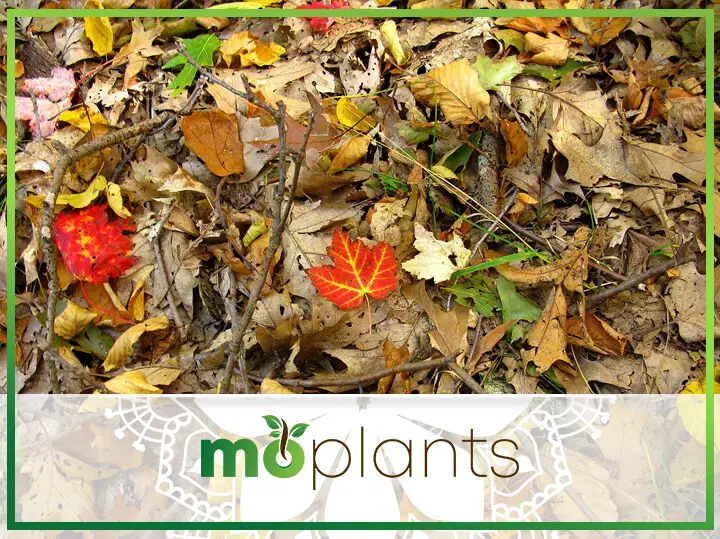Seeing autumn leaves indicates an end of the season for gardening. The fall season is here. It’s time to bring out the leaf blower and put in the work of raking leaves into piles.
For others, it’s exhausting work. But for gardeners, it’s harvesting a bounty from mother nature.
Fallen leaves can be used as mulch in vegetable gardens, shrubs, and flower beds. It’s natural, organic, and inexpensive. As leaves decompose over time, they release nutrients that benefit your plants.
Outline
Learn how to use piles of leaves as something useful for your yard, lawn, or vegetable gardens. Here’s an overview of what you’ll learn in this article:
- Composting at Home
- What is Leaf Mulch and How to Make It
- Leaf Molds and Leaf Compost
Composting at Home
A dedicated gardener spends a lot of time preparing their soil for the growing season. Some buy manure, while others buy soil additives. But one ideal solution is to make your own compost.
Compost is organic matter that improves the quality of your garden soil.
Benefits of Composting:
- Keeps your soil structure intact
- Balances your soil’s acidity
- Increases its water retention
Making your own compost keeps your own yard waste from crowding landfills. This prevents further production of methane, a greenhouse gas.
This benefits your home garden as well because it reduces the need for chemical fertilizers.
Natural compost enriches the soil and prevents plant diseases and pests. It encourages natural bacteria and fungi to break down natural waste.
This process transforms soil into hummus. This is very vital in growing healthy plants as hummus is moist and contains various nutrients.
Your ideal compost pile should consist of these three basic ingredients:
- Browns to provide carbon: dead leaves, straw, twigs, branches, wood chips, other yard waste from your lawn or garden.
- Greens to provide nitrogen: grass clippings, kitchen waste like fruit scraps, vegetable waste, eggshells, and any other kind of biodegradable material (you can check here to distinguish which kitchen scraps can be used for compost.)
- Water to provide moisture
The browns and greens should have a balanced ratio. You should also have them in alternating layers in your compost pile.
Composting leaves and other yard waste takes time. To utilize the leaves in your yard, you can make leaf mulches as soon as the fall leaves appear.
Leaves are very effective as both summer and winter mulch. Using leaves as mulch helps maintain the moisture of your garden beds.
What Is Leaf Mulch?
Mulch is any material that’s placed on top of the soil. This keeps the environment of the garden consistent and ideal for plant growth.
There are many ways to make mulch, and one of them is using leaves. Using leaf litter for mulch is an easy way to recycle debris from your yard.
Decomposition is much faster when using leaf mulch. Having a balanced amount of greens and browns can speed up the composting process.
Leaves are also more accessible when you have trees in your yard. There are many benefits to using leaves as mulch. As these piles of leaves decompose over time, they:
- Prevent weeds from growing around the plants
- Keep the soil moist and reduce surface evaporation
- Maintain soil temperatures (keeps the soil warmer in winter and cooler in the summer)
- Prevent soil erosion
- Transform to organic matter that gives nutrients to the soil
Soil-dwelling organisms live off on these shredded leaves. Doing so helps them produce nutrients that will be beneficial for the plants.
Earthworms, fungi, and bacteria work together throughout the decomposing process. They digest and transform leaves to create natural nutrients for the plant.
It improves your soil fertility and organic content.
How to Make Mulch From Leaves
For an effective leaf mulch, it’s not enough to leave it up to mother nature alone. Make sure you use leaves that are freshly fallen.
These leaves are highly rich in nutrients, so it is advised that these are to be used as mulch.
Once leaves start to fall, you have to start raking them onto one pile. Make sure you turn your leaf pile to keep your leaves nice and dry for shredding, as wet leaves do not shred well.
If you are in need of more leaves, collect them from some of your neighbors. Be courteous and ask them before you grab it. If not, you can collect from your local municipal waste center.
Some waste services keep yard waste at a central location. Find out from your waste management center if you can collect some leaves. Doing this will help lessen the waste that will end up in landfills.
Shredding
You’d want your leaf mulch to break down as quickly as possible. For this to happen, you have to shred the leaves. This prevents the leaves from creating a moldy mat inside your compost bin.
You can use a lawn mower to slice up the leaves. Remove sticks and branches from the pile to protect your lawn mower.
Spread your leaves in a thick layer and have the lawnmower go over the leaf bed slowly.
Use finely shredded leaves for your mulch. Whole leaves will prevent water from penetrating the top layer.
Once you have your shredded leaves, you can now put them into temporary holding bins or bags. It is recommended to have a leaf-centric bin where you can collect your shredded leaves.
You can separate them into different bins for the different processes you’re going to do (mulch, molding, and composting).
As much as possible, the structure of your holding bin should allow oxygen to penetrate the leaves easily. Using a closed plastic tumbler-styled bin can slow the breaking down process.
Benefits of Shredded Leaves
- Insulate tender plants: A layer of leaf mulch keeps the soil’s temperature consistent. It also prevents weeds from growing around plants.
- Balances your compost piles: Leaves are rich in carbon, which balances the nitrogen present in your compost.
- Soil maintenance: Using leaves attracts earthworms and other beneficial organisms. These little creatures feed on organic matter and produce nutrients for plant growth.
- Prevents molding: Ideally, you want the mulch to be as porous as possible for water to be absorbed. The smaller the leaves are shredded, the less likely they are to mat and mold.
Tip for Shredding Leaves
- Not all leaves are for shredding. The composition of walnut, eucalyptus, and camphor laurel leaves inhibit plant growth. They are better used as compost.
- Oak leaves are perfect for shredding. They’re clean and easily break down. Perfect leaves for leaf mulch.
You can leave the shredded leaves on your lawn and use them as lawn amendments. The leaves should not be too thick. Let the smaller pieces go in between the blades of grass and act as a natural fertilizer.
Vegetable Garden Mulch
The organic mulch will keep the soil cool and keep weeds from growing.
Vegetable plants like bulb onions, tomatoes, and pumpkins tend to have wider root zones when covered with a thick layer of leaf mulch.
When using dried leaves as mulch, you can make a layer of them that’s about 3 to 4 inches thick around trees and shrubs.
If you’re going to use them on raised beds, the mulch layer should be 2 to 3 inches thick. Use leaves as mulch for your vegetable beds to improve soil’s irrigation and increase its fertility.
The smaller the leaves are shredded for your mulch, the quicker they will break down.
Gardeners also use leaf mulch solely for insulation during winter. The higher or thicker the mulch pile, the more air is trapped inside. This gives the ground better insulation.
As the seasons continue to progress, the leaves will compress and layer. Don’t forget to pull them out once spring comes.
If you want to take it to another level, you can also make leaf mold and add it to your compost pile.
Leaf Mold
If untouched for too long, fallen leaves are rid of their minerals. Whole leaves take a while to decompose if they are not shredded. Without a source of nitrogen, these leaves turn into leaf mold.
Leaf mold is leaf mulch that had begun breaking down. It is not as mineral-rich as compost, but you can still use it to improve your soil fertility.
You can till leaf mold into garden beds to improve your soil structure and water-holding capability. It absorbs five times its weight in water and maintains the moisture levels of your garden soil.
Producing leaf mold is very much like making compost. Depending on the climate of your place, leaf molds can take years to form.
Whole leaves take around three years to break down into leaf mold. Shredded ones take around six months. You can speed things up and make your own leaf mold:
- Choose an area in your garden to use for your leaf pile.
- Cover your leaf pile with a plastic tarp to keep its moisture intact. You can also use garbage bags. Make sure to cut holes in it for airflow.
- Use a garden fork to turn your leaves from time to time. This helps speed up the decomposition process by giving your pile plenty of oxygen. Untouched leaves that are left to mold tend to pack tightly in layers, which delays the leaves’ molding process.
- If you’re using a plastic bag, shake the leaves so that air will flow in.
- Let it sit and check the pile from time to time. Add water if the leaves are dry.
- You can also make leaf molds in raised beds. Fill a raised bed with shredded leaves and cover it with plastic. This will speed the process over the winter season and have it ready just in time for spring.
Once your shredded leaves soften over time, moisten them with water. When it turns dark brown or black, you can now add it onto your vegetable garden bed along with the leaf mulch.
Properly processed leaf molds produce an earthy aroma and have a crumbly texture. Any leaf molds that were not used can be used for composting.
Leaf Compost
Composting leaves can save you a lot of money. Instead of purchasing manure and other packed fertilizers from your local market, you can utilize the leaves in your yard.
Leaves contain twice the mineral content of manure. Because they’re organic, they naturally improve the irrigation and porosity of your soil.
The composting process for leaves takes a while. Some gardeners add fertilizer or use a compost starter to speed it up.
But according to this research on leaf decomposition, the fungi that aid in the rotting process are already present on the leaves even before they fall.
This specific strain of fungi is activated with the right amount of moisture. Adding chemicals or unknown microorganisms to it will interrupt the natural process.
You can mix it with other brown and green ingredients to speed up the decomposition process. But keep the carbon-nitrogen balance.
Too much nitrogen from greens will make your pile smell and turn anaerobic.
You can use this process to help balance the carbon-to-nitrogen ratio inside a bin:
- Layer the bottom with twigs to aid in air circulation.
- Pour in a thick shredded leaf layer with a space in the center.
- Fill the center with kitchen scraps.
- Cover with a leaf layer.
- Repeat until the bin is full.
It’s recommended that you use a wire mesh bin for the pile to contact the ground directly.
This makes the pile more accessible for fungi and other organisms coming from the ground to speed up the decomposition process.
You can collect shredded leaves and keep them in a bin for composting. You can put them in separate bins or bags so the decomposing process will be easier to monitor.
Water and turn them from time to time to keep the oxygen circulating.
Your pile is fully decomposed when the materials in it are not recognizable anymore. It’s supposed to be dark brown and has a crumbly texture to it.
If you can, make sure to measure the pH levels of your soil. This will help you in choosing the leaves to add as different leaves have different acidity levels. These will affect your soil acidity.
What Leaves Should You Not Compost?
Different leaves have different substances. Some of which may do more harm to your plants. While most biodegradable materials are beneficial to soil fertility, some should be avoided.
Diseased Plants
Similar to humans, plants can spread diseases to each other too.
To keep your garden healthy, don’t put sick plants on your compost pile. Unless the environment is hot enough to kill pathogens, keep them in a separate area.
For safety, keep sick plants in a separate bin. If your area has cold temperatures, it’s better not to use sick plants.

Pine Needles
Needle-shaped leaves from conifer trees can be composted, but they will not break down quickly.
Evergreen conifers are made to withstand cold weather, giving them a tougher composition than most leaves.
They’re much more ideal to be used as mulch rather than compost.
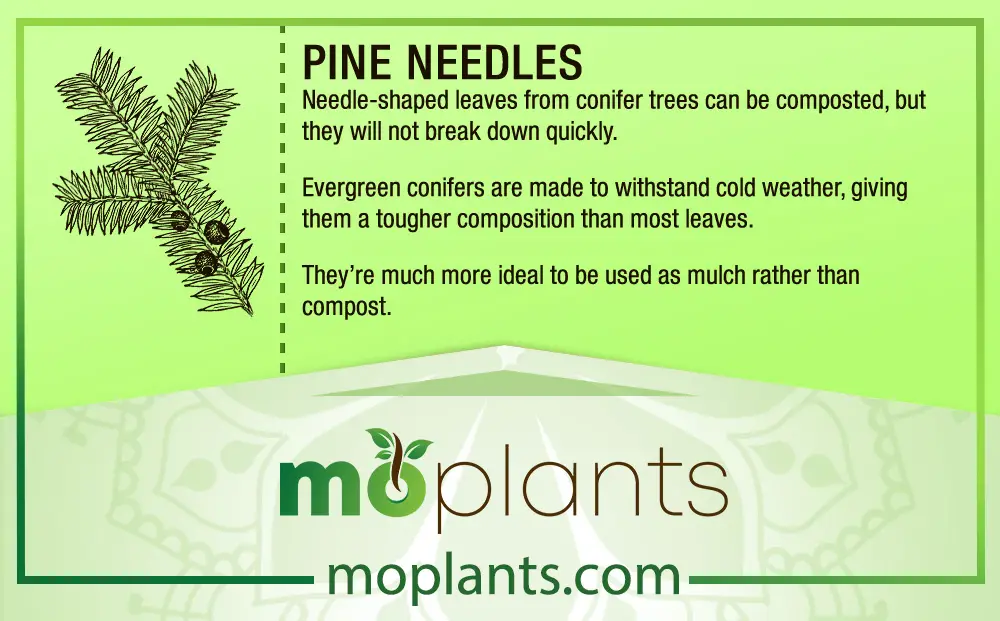
Black Walnut
Black Walnut trees produce this substance called Juglone. This is found in all parts of the black walnut tree as it is part of its natural defense system.
Juglone is also found in other walnut trees but has higher concentrations in black walnut.
This particular substance is poison for most plants, especially sensitive ones. Juglone can prevent plant species from growing and flourishing around black walnuts.
Avoid putting any kind of debris from black walnut in your compost at all costs.
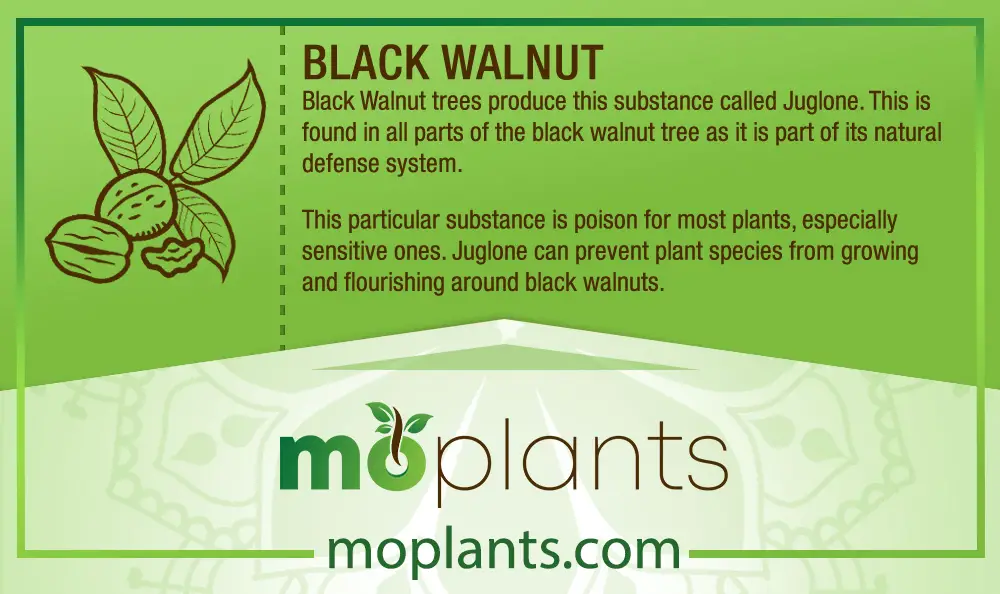
Broadleaf Evergreen Shrubs
Leaves from broadleaf evergreen trees take a long time to break down as they have a thicker texture compared to other leaves.
Consider composting them in a separate bin before adding them to your compost pile. Shredding these leaves can help them break down faster.
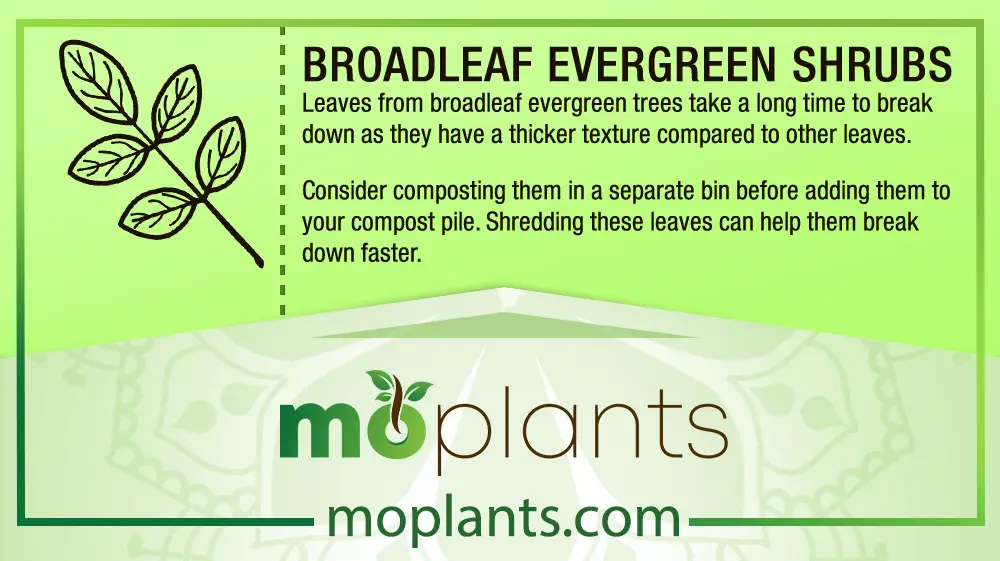
Infographic
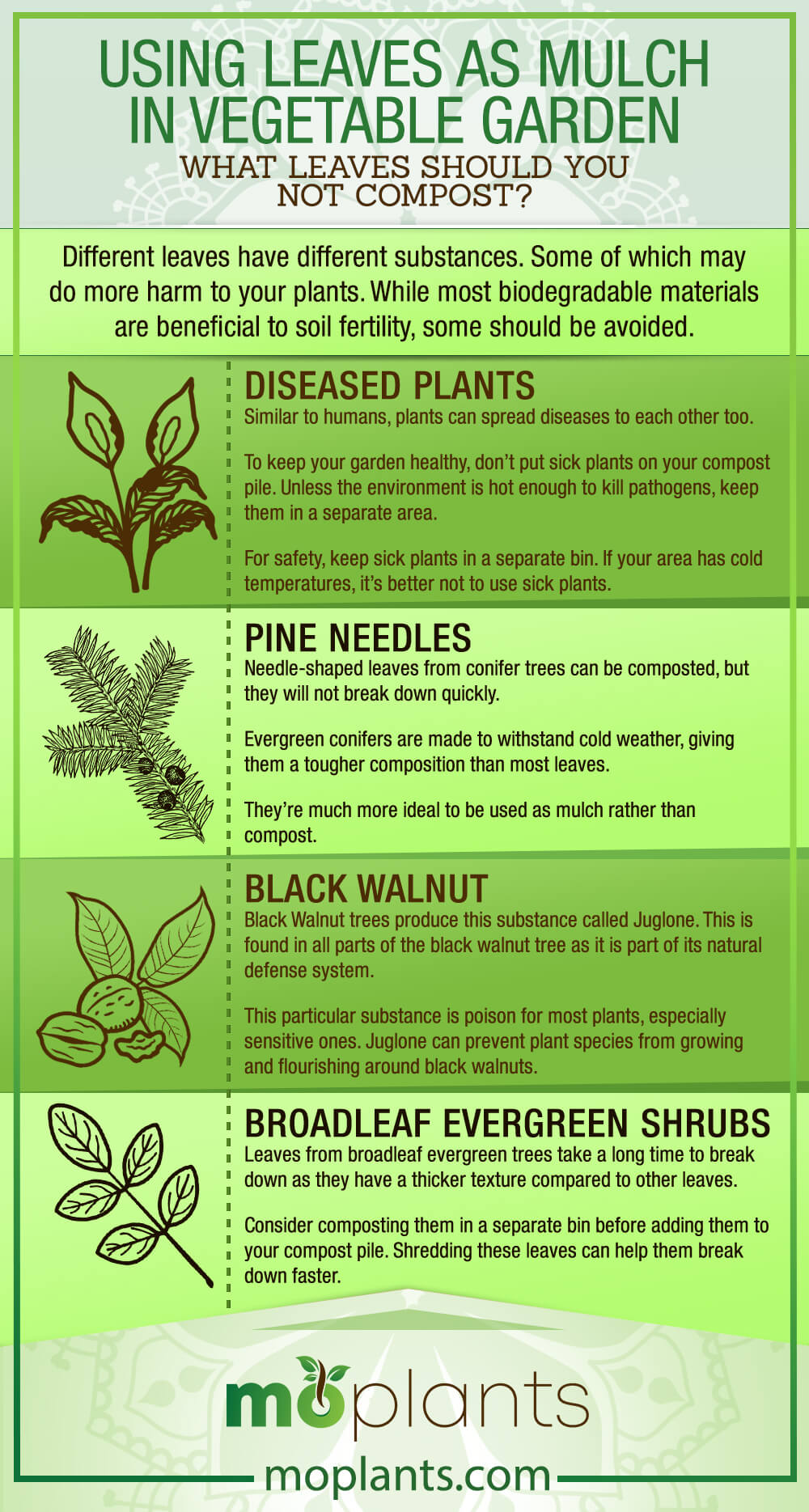
Recycle Your Leaves
Raking leaves in your yard definitely takes a lot of work. But these leaves are gardeners’ best treasure when it comes to maintaining your lawn.
Take advantage of the trees in your yard and collect fallen leaves.
One of the best ways to use these leaves is to make mulch out of them. Using leaf mulch for your vegetable garden will help maintain an ideal environment for your plant to flourish.
Instead of just throwing them away, you can make mulch, mold, and compost out of them. Gather them as soon as they fall.
The process may take a while, but it keeps your soil healthy and fertile until the next year. Do remember to be cautious of what kind of leaves you’re gathering for your pile.
If you have any questions regarding the three different processes, feel free to comment below!

